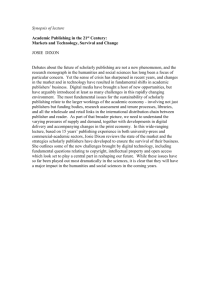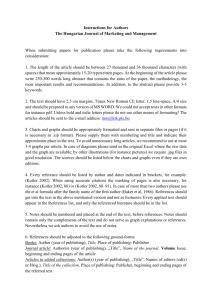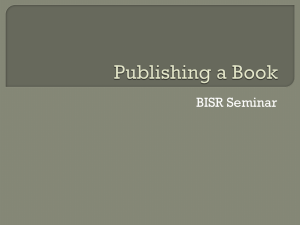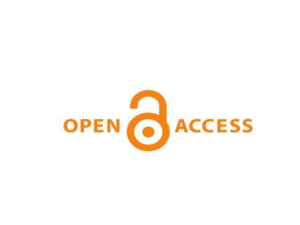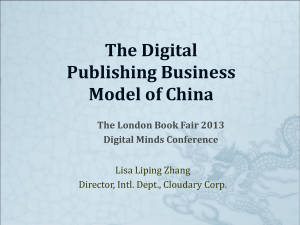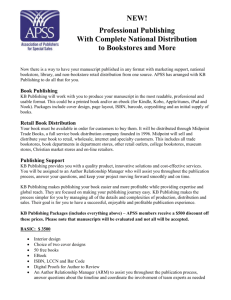Chapter Recaps & Study Guide
advertisement
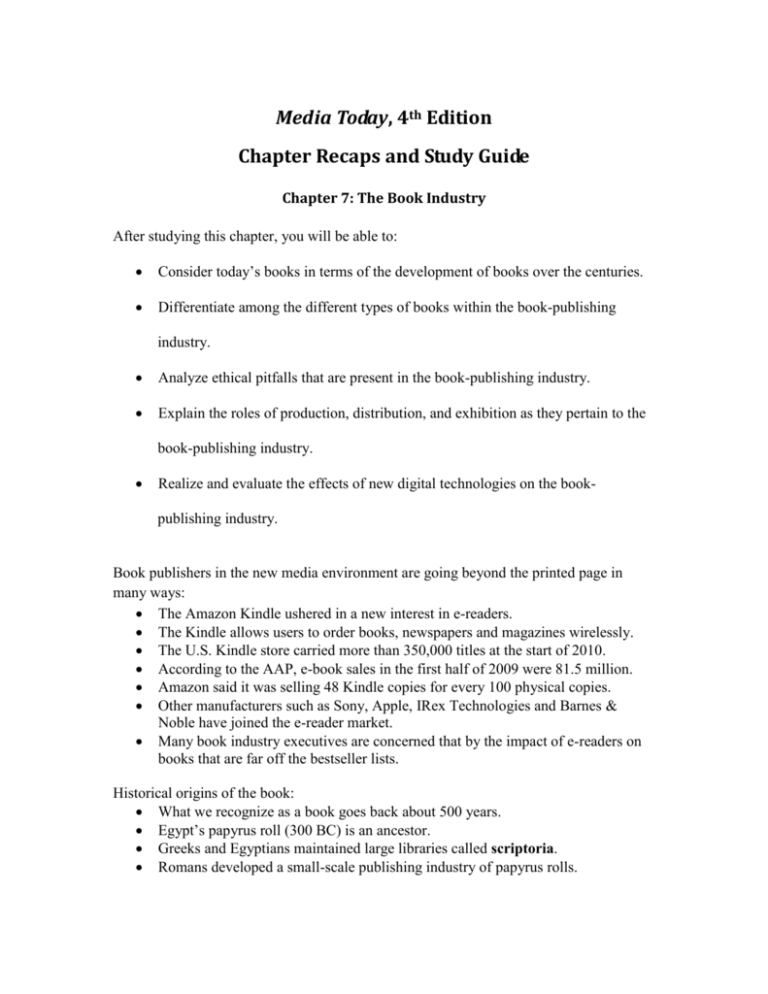
Media Today, 4th Edition Chapter Recaps and Study Guide Chapter 7: The Book Industry After studying this chapter, you will be able to: Consider today’s books in terms of the development of books over the centuries. Differentiate among the different types of books within the book-publishing industry. Analyze ethical pitfalls that are present in the book-publishing industry. Explain the roles of production, distribution, and exhibition as they pertain to the book-publishing industry. Realize and evaluate the effects of new digital technologies on the bookpublishing industry. Book publishers in the new media environment are going beyond the printed page in many ways: The Amazon Kindle ushered in a new interest in e-readers. The Kindle allows users to order books, newspapers and magazines wirelessly. The U.S. Kindle store carried more than 350,000 titles at the start of 2010. According to the AAP, e-book sales in the first half of 2009 were 81.5 million. Amazon said it was selling 48 Kindle copies for every 100 physical copies. Other manufacturers such as Sony, Apple, IRex Technologies and Barnes & Noble have joined the e-reader market. Many book industry executives are concerned that by the impact of e-readers on books that are far off the bestseller lists. Historical origins of the book: What we recognize as a book goes back about 500 years. Egypt’s papyrus roll (300 BC) is an ancestor. Greeks and Egyptians maintained large libraries called scriptoria. Romans developed a small-scale publishing industry of papyrus rolls. Religious Christians invented the codex around 100 AD, with pages facing each other; vellum, parchment, and paper eventually replaced papyrus. Early books were hand produced. Gutenberg and the advent of movable type: His major contribution to the development of printing was the use of movable type. Printing expanded rapidly in Europe in the 1400s. By the 1500s, books circulated secular ideas that challenged the established power structure, and encouraged the Protestant Reformation, the Renaissance, the growth of science, and ideas about democracy. The book in England: The British Crown established a licensing system to control what was published; several strategies were used to control printers. A 1637 law reduced the total number of printers to 23, prompting John Milton’s famous argument against censorship, the Areopagitica. In the 1680s, a law was passed that gave freedom of expression to Members of Parliament, and printers in British American colonies argued that this freedom should be extended to everybody. Early booksellers acted as publishers, printers were paid very little, and authors had little control over their work.. Publishers, separate from booksellers, controlled the publishing of books by the eighteenth century, leading to the British Copyright Act of 1709 (the first copyright act in any country). In British American colonies, the first press operated in Massachusetts in 1639; production was very limited, expensive, and labor-intensive. U.S. book publishing becomes an industry: The introduction of the Hoe steam-powered cylinder press, increased literacy, an influx of immigrants, and the development of transportation into the American interior encouraged the industrialization of US book publishing in the 1830s (similar to the development of the newspaper industry’s penny press, the first U.S. mass medium). By 1855, the U.S. surpassed England in book sales. US publishers reprinted British novels without paying royalties, because the U.S. government refused to recognize the copyright laws of foreign countries. The U.S. joined the International Copyright Convention in 1891, after foreign publishers started using American material without paying royalties. Dictionaries, law and medical books, religious books, textbooks, and novels were popular forms of content. The advent of the dime novels and domestic novels: Dime novels (appearing in the 1860s) were forerunners of the paperback book; authors were paid fees, not royalties, to write in highly formulaic genres aimed mostly at men and boys. Domestic novels (appearing in the 1870s) were forerunners of soap operas and Harlequin romances; heroines sinned, suffered, and repented; these books were aimed mostly at women. The broader industry adopted strategies similar to those carved out by the publishers of the dime novels and domestic novels, and tried to sell inexpensive books and book series; book sales occurred in bookstores, through the mail, in department stores, and at discount outlets by the end of the nineteenth century. Conglomerates in the book industry: Conglomeration began to occur in the 1960s, driven in part by the lucrative textbook business. Today, several international conglomerates target different audiences with specific content; today’s publishing business is less genteel than it was in the early and mid-twentieth century. The book industry today: The book industry is growing and economically healthy; books are currently divided into the following categories: o Educational and training books, marked by their use of pedagogy (learning apparatus), including learning objectives, chapter recaps, questions for discussion, etc.; they include these three sub-categories: El-Hi books and materials are created for students in kindergarten through twelfth grade. Higher education books are those that focus on teaching students through college and post-college learning; professional books help continue the learning process beyond college. Outsourced corporate training materials are books and related materials used to help employees keep up-to-date in their professional areas; the term “outsource” means that a company hires a firm to do the training, either in classrooms or via the internet. o Consumer books are aimed at the general public; they include these seven sub-categories: Trade books are general interest titles, including both fiction and non-fiction; typically sold at retail bookstores and to libraries; divided into adult and juvenile. Mass market paperbacks are smaller than standard-size trade paperbacks and are sold at mass market outlets. Religious books are trade books that contain religious content; they are sold at religious bookstores and general bookstores. Book clubs are organizations through which individuals who have joined can select books from the club’s catalog and purchase them through the mail or via the club’s website; traditionally, they have operated on a negative-option plan, requiring consumers to cancel their memberships or otherwise receive “main selection” books on a monthly basis. Mail-order books are advertised on television and in mailings and require consumers to use an 800 phone number to order books with a credit card. University press books are quite varied and can fit into several of the previously listed categories; they’re distinguished by their type of publisher—a university or other non-profit educational institution that operates a publishing house; some titles are sold through the mail to scholars interested in particular topics. Subscription reference books constitute various “great books” series, and dictionaries, atlases, and encyclopedias, sold door-todoor or via direct-mail; several volumes are sold at a time with a deferred payment schedule. Variety and specialization in book publishing: Financing book publishing. o In the US, about 83,000 publishing houses issue about 291,000 new titles of editions each year; low entry costs encourage a lot of players. o Companies can stay afloat if they specialize. o Although there are many book publishers, a handful dominate the most lucrative areas of the industry, because some areas of book publishing can be very expensive, especially the composition services that print color photographs and special layouts. Production in the book publishing industry: Production in trade publishing. o The acquisitions editor recruits and signs new authors and titles. o Authors may be paid a flat fee or may earn royalties from the sale of the book. o An executive board typically gives permission for a manuscript to move forward to publication, at which time it passes along to a development editor. o Literary agents market manuscripts to editors, publishers or other potential buyers. o In the hardcover trade end of the industry, a bestseller achieves sales of 50,000 copies; a blockbuster achieves sales of 100,000 copies. Production at a university press. o Major success means selling several thousand copies (far fewer than in the hardcover trade area); success is often based on commanding respect from academics who tell their students and university libraries to buy copies. o Editors rely on consultants who give them tips about young academics (potential writers) whose work seems promising; established academics can’t meet the entire demand for scholarly work. o Academic conferences are typically used to publicize books; brochures are sent to scholars who specialize in topics. Book production in the electronic age. o The biggest book publishers are active in creating books for the electronic market, despite the fact that little money is made from the sale of electronic books and that e-books are not well developed. o At present, electronic books are in an experimental phase; there seems to be little consumer interest in devices such as Amazon’s e-book reader. o The sale of textbooks in digital form has been somewhat successful, as well as the posting of certain titles online at the same time they go on sale as books. o Some books are now released online and offline at the same time. o The future of the electronic book remains uncertain. Ethical pitfalls in book publishing. o Ethical issues for authors include plagiarism—the use of another person’s work without citing or otherwise crediting the original author. o Ethical issues for editors and literary agents include stealing ideas from unknown authors and assigning better known authors the job of turning the ideas into books; sometimes unscrupulous agents charge authors fees to represent them but then don’t follow through. Reducing the risks of failure during the production process. o Conducting prepublication research to gauge a title’s potential success. o Making use of authors’ track records to gauge a title’s potential success; authors who typically receive large advances and sales are: Previously hugely successful Controversial Well known outside of book publishing. Offering advances on royalties. o Such advances are payments to authors before their books are published; based on the anticipated author’s earnings on the book; far more common in trade publishing than in university press publishing. o When determining an advance, a publisher considers potential hardcover sales, paperback sales, and foreign sales; advances typically go to authors involved in other media and who are well known. o Risk reduction strategies sometimes do not work, because readers get tired of overworked trends. Distribution in the book industry: The role of whosesalers in the distribution process: they purchase copies from publishers and then sell them to retailers (exhibitors) at a discount; the wholesaler risks giving too much storage space to a title; the publisher risks getting unsold copies returned, so the publisher must be realistic about the print run (the number of copies printed). Assessing a title’s popularity rests on three indicators: o Popularity Indicator 1: The size of the print run. o Popularity Indicator 2: The content of reviews. o Popularity Indicator 3: The scope of the marketing plan (including the author’s book tour). Exhibition in book publishing: Exhibition in trade book publishing. o Retail bookstores o Libraries o Mail-order, subscription, and book club sectors distribute titles directly to consumers. Exhibition in textbook publishing. o The exhibition area for el-hi books is constituted by the evaluation boards that determine purchases; Texas and California are most influential in this process, because the selection process is centralized, and the states are very large. o College level textbooks are assigned by professors; new editions of college textbooks have two purposes: New editions have more up-to-date information. Publishers discourage used book sales in order to maintain profit; revised editions of popular textbooks keep publishers in business. Several states have passed laws that attempt to keep textbook prices as low as possible. o Exhibition via bookstores. Bookstores are either chain bookstores or independent bookstores. Chains have moved into the hardback trade market once dominated by the independents. Independent bookstores have had a hard time surviving, because consumers have shifted to the chains and because wholesalers shortened the time the independents have to pay them for books; publishers have extended credit to the chains. Sales by independents have declined because of the success of chains. o Exhibition via the Web. Amazon, Barnes & Noble, and Borders have all developed successful online sales operations. Media literacy and the book industry: The book publishing industry demonstrates two of the six trends currently operating to reshape media industries: the blurring of media boundaries and digital convergence. A title that moves content across media boundaries is typically presold (the publisher expects it will sell well to specific audiences because it ties into material that is already popular with the target audience; book lovers are concerned about this process, because they fear it may drive out other titles from the marketplace. The media literate person may well ask these questions about the book industry: o To what extent are the books that are getting most of the media attention today generated as a result of an author or character’s popularity in another medium? o Are we seeing an increase in cooperative activities between movie companies and book publishers owned by the same conglomerate? That is, are movie companies mostly using the publishers to sell books that publicize the movies, and are book companies trying to come up with titles that can become films?
